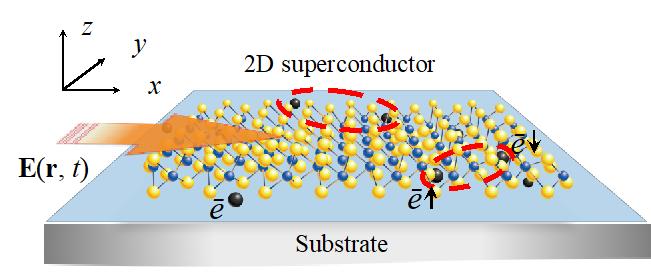주메뉴
- About IBS 연구원소개
-
Research Centers
연구단소개
- Research Outcomes
- Mathematics
- Physics
- Center for Underground Physics
- Center for Theoretical Physics of the Universe (Particle Theory and Cosmology Group)
- Center for Theoretical Physics of the Universe (Cosmology, Gravity and Astroparticle Physics Group)
- Dark Matter Axion Group
- Center for Artificial Low Dimensional Electronic Systems
- Center for Theoretical Physics of Complex Systems
- Center for Quantum Nanoscience
- Center for Exotic Nuclear Studies
- Center for Van der Waals Quantum Solids
- Center for Relativistic Laser Science
- Chemistry
- Life Sciences
- Earth Science
- Interdisciplinary
- Center for Neuroscience Imaging Research (Neuro Technology Group)
- Center for Neuroscience Imaging Research (Cognitive and Computational Neuroscience Group)
- Center for Algorithmic and Robotized Synthesis
- Center for Genome Engineering
- Center for Nanomedicine
- Center for Biomolecular and Cellular Structure
- Center for 2D Quantum Heterostructures
- Center for Quantum Conversion Research
- Institutes
- Korea Virus Research Institute
- News Center 뉴스 센터
- Career 인재초빙
- Living in Korea IBS School-UST
- IBS School 윤리경영


주메뉴
- About IBS
-
Research Centers
- Research Outcomes
- Mathematics
- Physics
- Center for Underground Physics
- Center for Theoretical Physics of the Universe (Particle Theory and Cosmology Group)
- Center for Theoretical Physics of the Universe (Cosmology, Gravity and Astroparticle Physics Group)
- Dark Matter Axion Group
- Center for Artificial Low Dimensional Electronic Systems
- Center for Theoretical Physics of Complex Systems
- Center for Quantum Nanoscience
- Center for Exotic Nuclear Studies
- Center for Van der Waals Quantum Solids
- Center for Relativistic Laser Science
- Chemistry
- Life Sciences
- Earth Science
- Interdisciplinary
- Center for Neuroscience Imaging Research (Neuro Technology Group)
- Center for Neuroscience Imaging Research (Cognitive and Computational Neuroscience Group)
- Center for Algorithmic and Robotized Synthesis
- Center for Genome Engineering
- Center for Nanomedicine
- Center for Biomolecular and Cellular Structure
- Center for 2D Quantum Heterostructures
- Center for Quantum Conversion Research
- Institutes
- Korea Virus Research Institute
- News Center
- Career
- Living in Korea
- IBS School
News Center
Controlling Superconductors with LightNew theoretical study shows how to use Terahertz light to peep in the secrets of two-dimensional superconductors A researcher at the Center for Theoretical Physics of Complex Systems, within the Institute for Basic Science (IBS, South Korea), Professor Ivan Savenko, has reported a conceptually new method to study the properties of superconductors using optical tools. The theory was published in Physical Review Letters and co-authored by Doctor Vadim Kovalev, physicist at the A.V. Rzhanov Institute of Semiconductor Physics (Russia). Below some temperature, the resistivity of a material can disappear, and thus, superconducting properties emerge. These are usually extremely low temperatures, between -200°C and -272°C, where commonly unbound electrons suddenly change their behavior and pair up, forming Cooper pairs. This transition manifests itself with supercurrents, which can circulate in the material forever without losses. However, superconducting properties can appear slightly above the critical temperature. In this so-called fluctuating regime, Cooper pairs start to appear and disappear, drastically altering the electric conductivity and other properties of the superconductor. More than fifty years ago, Aslamazov and Larkin developed a theory which says that the conductivity of fluctuating superconductors is mediated by both unbound electrons and Cooper pairs. However, fluctuating superconductivity is such a challenging research topic that it continues to be investigated. In this new study, the researchers suggest a way to monitor these electron transport phenomena with optical spectroscopy, an experimentally available optical platform. “While the resistivity-based and magnetic methods to monitor superconductors are well established, it is very hard to “marry” light and superconductivity,” explains Savenko. “This is a hot research field where we can expect new discoveries in fundamental science and innovative applications.” Superconductivity and light are two seemingly unrelated phenomena. Usually, superconductors are not very sensitive to external light: they can only weakly interact with it, and rather serve as mirrors. This study, instead, shows that light at terahertz (THz) frequencies, which lie between the radio and infrared domains, could be used to optically explore the properties of superconductors. The researchers modelled the optical and electrical responses of a 2D fluctuating semiconducting layer exposed to THz waves. Approaching the critical temperature, the emerging Cooper pairs cause significant changes in electric conductivity and light absorption by the system. The unbound electrons act as mediators, interacting with both Cooper pairs and light. “The design we developed is very simple. Therefore, we believe that our discovery can be applicable to multiple cases,” says Savenko. “We expect that the corresponding experiment will be conducted in the near future. It should show either the modification of the electric current, or the alteration of the reflected or transmitted light spectrum, depending on the density of the Cooper pairs.”
These theoretical findings could be translated into experiments that use fluctuating superconductors in THz devices, which are in high demand nowadays. THz waves find applications in high-resolution imaging, non-invasive tumor detection, and telecommunications. It is a fascinating field targeting many open questions. Notes for editors - References - Media Contact - About the Institute for Basic Science (IBS) |
|||
|
|
| Next | |
|---|---|
| before |
- Content Manager
- Public Relations Team : Yim Ji Yeob 042-878-8173
- Last Update 2023-11-28 14:20












